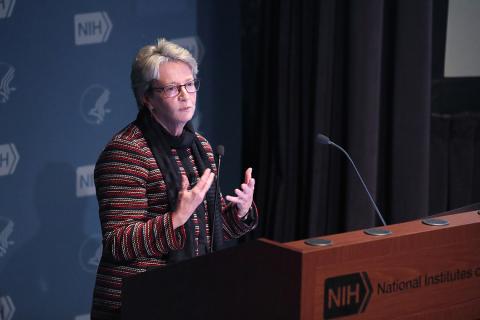Managing Inner-City Pediatric Asthma

Photo: Chia-Chi Charlie Chang
When managing chronic conditions such as asthma, health care providers need to look beyond the standard doctor’s visits and taking medications as prescribed. Dr. Arlene Butz has devoted her life’s work to investigating the many factors that contribute to childhood asthma. She discussed this work at the first NINR Director’s Lecture of 2019. Her studies of childhood asthma in inner-city Baltimore are prime examples of how complicated it can be to develop home-based interventions for managing chronic conditions.
“I think most of the self-management happens in the home and that’s where we need to help caregivers make the right decisions” about asthma care for their child, noted Butz. One of the critical decisions caregivers make for children with asthma is when to give medication. Butz found through her studies that instead of being given long-term controller medicines, many children are given rescue medication—which is supposed to be used for asthma emergencies—for routine management of their asthma. Butz’s research found that managing medications was only one of many factors contributing to children’s poor asthma control.
During home visits for one of her studies, nurse interventionists reported children having high exposure to secondhand smoke and contamination of nebulizer equipment. This prompted Butz and her team to take a closer look at home environments and whether there were other factors that could be contributing to poor management of the children’s asthma.
A secondary study showed that 37.5 percent of nebulizer tubing and masks from study homes tested positive for environmental allergens such as dog, mouse and cockroach. “This helped us realize the importance of what’s in the home environment,” Butz said.
She also used biomarkers of allergy and indoor exposure (dog, cat, mice, cockroach and secondhand smoke) and found that 83 percent of the children in the study had at least one positive allergen sensitization and 55 percent were exposed to secondhand smoke. By looking at allergens on an individual home level, the study was able to provide personalized interventions—such as mouse traps and trash cans for homes with mouse allergens and mattress covers for homes with dust mite allergens.
Butz’s studies uncovered important lessons that she was committed to sharing with study participants in a meaningful way. She and her team created a short, animated video to communicate study results, instead of a more traditional letter to study participants. The video (https://vimeo.com/261407654) graphically depicts the most important lessons and helps educate the study participants’ families about how to better manage their child’s asthma.
Improved self-management of asthma and other chronic conditions is an ongoing research area. The potential to avoid visits to the emergency room, hospital stays and negative health outcomes is tremendous. If caregivers prioritize the home environment, personalized treatment plans and improved communication efforts, patients’ quality of life can be enhanced and their symptoms better managed.
Butz is professor of pediatrics at Johns Hopkins University School of Medicine with a secondary appointment in the School of Nursing. The full video of her lecture is available at https://videocast.nih.gov/summary.asp?Live=31581&bhcp=1.
